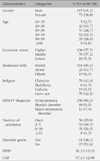Abstract
Purpose
The purpose of this study was to identify the relationship between hope, depression and suicidal ideation in patient with chronic mental illness patients.
Methods
The subjects were 188 patient with chronic mental illness in a Community Mental Health Center. The data were collected from July 27 2009 to August 21, 2009. Data were analyzed using descriptive statistics, pearson correlation coefficients, and stepwise multiple regression.
Results
There was found significant and negative correlation among hope and suicidal ideation; significant and positive correlation was found between depression and suicidal ideation; a significant and negative correlation among hope, depression and suicidal ideation. Depression was a significant predictor of suicidal ideation.
Conclusion
Hope, depression and suicidal ideation in chronic mental illness patients, and significant correlations between their relationships. Based on the outcomes of this study, it is necessary to design an intervention program that emphasizes increasing the hope and decreasing depress in order to decrease suicidal ideation.
References
1. Ahern L, Fisher D. Recovery at your own pace. J Psychosoc Nurs Ment Health Serv. 2001; 39(4):22–31.

2. Anthony W, Cohen M, Farkas M. Psychiatric rehabilitation journal. Boston: Center for Psychiatric Rehabilitation;1990.
3. Beck AT, Ward CH, Mendelson M, Mock J, Erbaugh J. An inventory for measuring depression. Arch Gen Psychiatry. 1961; 4:561–571.

4. Beck AT, Kovacs M, Weissman A. Assessment of suicidal intention: The scale for suicidal ideation. J Consult Clin Psychol. 1979; 47:343–352.
5. Choe KS, Kim HJ, Noh CH. Hope in people with schizophrenia: Concept clarification. J Korean Acad Psychiatr Ment Health Nurs. 2005; 14(4):417–427.
6. Cutcliffe J, Herth K. The concept of hope in nursing 2: Hope and mental health nursing. Br J Nurs. 2002; 11(13):885–893.

7. Czuchta DM, Johnson BA. Restructuring a sense of self in the patient with chronic mental illness. Perspect Psychiatr Care. 1998; 34(3):31–36.
9. Harwood D, Jacoby R. Suicidal behavior among the elderly. In Keith Hawton (Ed.), The international handbook of suicide and attempted suicide. John Wiley & Sons. Ltd;2000.
10. Hong JA. The analysis of influencing factors of psychiatric inpatients' hope. Unpublished master dissertation. Seoul: Catholic University;2001.
11. Hyun MY, Lee JE, Park SN. A study on the adolescents' hope and mental health. J Korean Acad Psychiatr Ment Health Nurs. 2003; 12(2):116–123.
12. Jae YM. Suicide and psychiatric disorder. Korean J Biol Psychiatry. 2004; 10(1):3–10.
13. Jeong HK. Relationships among schizophrenic patients' hope, social support, and the quality of life. Unpublished master's thesis. Seoul: Korea University;2008.
14. Johnson M. Being mentally ill: A phenomenological inquiry. Arch Psychiatr Nurs. 1998; 12(4):195–201.
15. Kim TH. The effects of hope and meaning of life on adolescent's resilience. Unpublished doctoral dissertation. Seoul: Hanyang University;2004.
16. Korean association for suicide prevention. Release copy of Korean association for suicide prevention. 2006. 09. Web site: http://www.suicideprevention.or.kr/notice/notice_02_view.htm?idx=16&article_num=12&bbs_id=notice_02&bbs_kind=notice.
18. Lang RS, Hensrud DD. Clinical preventive medicine. 2nd ed.Chicago: American Medical Association;1996.
19. Lee ES. Construction of structural model about adolescent's alienation depression and suicidal thought. Unpublished doctoral dissertation. Seoul: Kyunghee University;2002.
20. Min SG. Modern psychiatry. Seoul: Ilchokak;2006.
21. Oquendo MA, Malone KM, Mann JJ. Suicide: Risk factor and prevention refractory major depression. Depress Anxiety. 1997; 5:202–211.
22. Park HS, Koo HY, Schepp KG. Predictors of suicidal ideation among high school students by gender South Korea. J Sch Health. 2005; 76(5):181–188.

23. Qin P, Agerbo E, Westergard-Nielsen N, Eriksson T, Moertensen PB. Gender differences in risk factors for suicide in Denmark. Br J Psychiatry. 2000; 177:546–550.

24. Roberts AR, Yeager K, Seigel A. Obsessivecompulsive disorder, comorbid depression, substance abuse, and suicide attempts: Clinical presentations, assessments, and treatment. Br Treat Crisis Interv. 2003; 3(2):145–168.

25. Schwartz RC, Cohen BN. Psychosocial correlates of intent among patients with schizophrenia. Compr Psychiatry. 2001; 42(2):118–123.
26. Shin MS, Kim ZS, Park KB. The cut-off score for Korean version of Beck Depression Inventory. Korean J Clin Psychol. 1993; 12(1):71–81.
27. Shin MS, Park KB, Oh KJ, Kim ZS. A student of suicidal ideation among high school students: The structural relation among depression, hopelessness, and suicidal ideation. Korean J Clin Psychol. 1990; 9(1):1–19.
28. Statistics Korea. Statistics Annual Report. Unpublished manuscript. 2008.
29. Steen M. Essential structure and meaning of recovery from clinical depression for middle-adult women: Phenomenological study. Issues Ment Health Nurs. 1996; 15:359–371.
30. Synder CR, Sympson SC, Ybasco FC, Border TF, Babyak MA, Higgins RL. Development and validation of state scale. J Personal Soc Psychol. 1996; 70:321–335.




 PDF
PDF ePub
ePub Citation
Citation Print
Print






 XML Download
XML Download